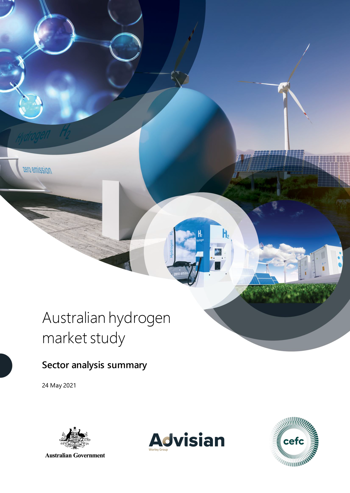
Insights
The Australian Hydrogen Market Study
Analysis of the competitiveness of green hydrogen across 25 Australian industry sectors
This report provides insights into the commercial viability of green hydrogen over three timeframes, and includes detailed analysis of the economic, technology and infrastructure factors that will underpin the green hydrogen economy. It was commissioned to help identify investment opportunities for hydrogen producers, large-scale energy users and potential investors.
About this report
The Australian Hydrogen Market Study
May 2021
The Australian Hydrogen Market Study was developed by the CEFC with analysis from Advisian.
Read moreThere is enormous excitement around the potential to create green hydrogen to deliver a cleaner and more enduring energy source. Our experience in developing the solar and wind sectors shows that prices decline rapidly as a new industry reaches scale and technical proficiency. It is encouraging to see a similar trajectory for the exciting hydrogen sector.
about the industry
Green hydrogen market drivers
- Electrolyser capital cost trends. This will largely be driven by global developments through increased research and development spend and value manufacturing at scale, similar to the solar and wind industries.
- The continued dramatic decline of renewable energy costs. High utilisation rates (or load factors) of electrolysers will drive the lowest cost hydrogen for the foreseeable future, requiring large amounts of low-cost solar and wind supplied from the grid. This will rely on the continued decarbonisation of the grid.
- Installation and operational efficiencies will be needed. As electrolyser equipment costs decline over time, the balance of plant and installation costs will likely make up a higher proportion of total costs. Pathways to drive installation efficiencies will be critical to expanding the industry.
report findings
Market potential
- Green hydrogen is already approaching cost competitiveness for heavy trucking, buses and remote power, with the potential to become commercially viable across further sectors of transportation as early as 2030.
- Parallel advances in production and distribution costs, as well as ongoing technology evolution, will accelerate the commercial attractiveness of green hydrogen across key areas of the economy.
- Large-scale development is critical to driving down installation and commissioning costs. While hydrogen was closest to achieving commercial parity as an alternative to petroleum products, displacing natural gas provides a potential transitional use to reach scale at pace.
- The export of hydrogen is forecast to be a key enabler of the global low carbon economy – however, the inherent low density of hydrogen makes the economics of international export challenging based on current technologies.





